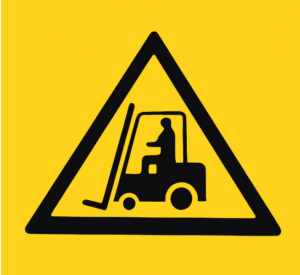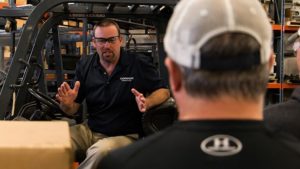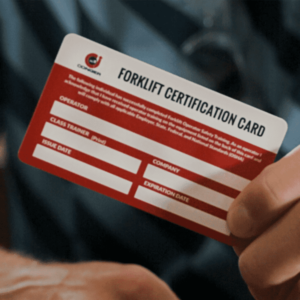Our forklift safety training guide will give you everything you need to identify hazards and common causes of incidents, evaluate your current safety training procedures, and get you started developing your safety training program.
Let’s get started! Click below to skip ahead:
The Science Behind Forklift Operator Safety Training

Whether you are a small company with only a few employees or a large corporation responsible for thousands of jobs, safety training is a substantial expense for employers.
It does not just cost money, but it also takes time too. Training and evaluating your employees is enormously time-consuming, so much so that you may have an entire department allocated to training. So why do we do it?
Your answers may range from “Because it’s required by OSHA” to “Because we want to keep our employees safe whether they’re operators or pedestrians working near forklift operation.”
Either way, the good news is that all the time and money we spend on safety training will keep our personnel safer.
In 1984, the National Institute for Occupational Safety and Health (NIOSH) conducted a study to determine the effectiveness of a forklift safety training program. The results indicate that better training reduces operators’ errors.
According to OSHA and many other experts, when you reduce errors, accidents are reduced as well. Thus, safety training is vitally important to our employees’ safety.
The trick is providing the best safety training to your forklift operators and pedestrians. Lucky for you, we’re here to help!
Recognizing Major Hazards

If you are new to safety training, you may not realize how many hazards are present in the workplace. Let’s start with some available data on fatalities and injuries related to forklifts.
Common Causes of Fatalities
A NIOSH study including 1,021 workers who died from injuries due to a forklift-related incident concluded that the following four items were the most common causes of death.
- Vehicle overturns (22% of the victims)
- Pedestrian struck/run over by vehicle (20% of the victims)
- Victims crushed by forklift (16% of the victims)
- Fall from forklift (9% of the victims)
Common Causes of Forklift Accidents
The best way to prevent these incidents is to inform operators and pedestrians of the risks and instruct them on safe operating and traveling practices.
Read more on preventing common forklift accidents.
Workplace Accidents
There are a multitude of workplace hazards that may affect your employees. They differ depending on the type of forklift and your application.
For example, a sit-down rider lifts loads much higher than a walkie-pallet jack. Therefore, sit-down riders have a greater chance of being involved in an accident with a falling load.
Likewise, pedestrians can be at greater risk in retail applications due to the high frequency of pedestrians working near forklift operations. Also, the typical retail facility floor plan does not allow many barriers between forklifts and pedestrian aisles.
Regardless of your forklift type, your forklift operators and pedestrians should be aware of the hazards associated with your work site and application.
Here are a few hazards that may apply:
- Obstructed view: Carrying a load can obstruct the operator’s view. Additionally, cross aisles and blind corners can also cause issues. If a load obstructs their view, operators should drive backward to maintain clear visibility.
- Grades, ramps, or inclines: Overturns can often happen when the lift truck is not on a flat surface. Operators should travel slowly on an incline. Pedestrians should not approach the forklift when it’s on an incline.
- Special attachments: Many applications use special attachments that alter the forklift’s capacity, stability, and load center. They can also reduce the operating clearance of the forklift (height or width). Operators should be aware of the changes these attachments may make to the forklift’s capabilities and respond appropriately.
- Unstable loads: Loads that are too heavy, too high, or uneven can become unstable and may fall on pedestrians and operators.
- Loading docks: Loading docks present a universal hazard in almost every application. If the trailer at the loading dock is not secured, lift trucks and pedestrians could fall through the gap. Review proper loading dock procedures with every employee working in the area.
Walk through your facility and identify hazards that both operators and pedestrians will encounter during their daily activities.
Any hazards that may affect your work site and application must be covered in your operator safety training as work site-specific instruction.
Now, let’s examine what else operator safety training requires.
Proper Forklift Operator Safety Training: According to OSHA

Even though we do not invest in training solely because OSHA mandates it, their requirements are mandatory.
OSHA has regulations covering every aspect, from training and assessment to record-keeping. Here are the details on exactly what your operator safety training should include.
Training Requirements
Generally, forklift operator training should cover:
- the types of lift trucks used in your specific work environment
- hazards created by the use of those vehicles
- general safety requirements (such as the pre-shift inspection)
- general principles of safe forklift operation
This training should be both lecture and practical instruction.
According to OSHA standards, an outside consultant can provide training. However, as the employer, you must provide evidence of classroom and practical training. You’ll also have to confirm that your operators are competent and safe.
Evaluations and Refresher Training
Evaluations must be completed after the initial training to verify that employees have acquired the necessary knowledge to operate a forklift.
Subsequent evaluations must be completed every three years after the initial training.
These evaluations can be a discussion with the employee, written documentation of previous training, performance testing, or simply observation of the employee. Refresher training is needed if the evaluation reveals that the employee operates the forklift unsafely.
Refresher training also is necessary under these circumstances:
- At any point, an employee operated a lift truck unsafely.
- Following involvement in an accident or near-miss incident.
- When an employee is assigned to operate a different type of lift truck.
Evaluating Your Current Forklift Operator Safety Training

Take a hard look at your operator safety training.
Are your operators provided the information and guidance they need to be competent, efficient, and safe? Does your training include site-specific safety instruction? Are your operators trained on each type of industrial equipment they will be operating?
Ask questions as you evaluate your current training and look at the mistakes we often see in training programs.
Online Training Pitfalls
Some companies use online training sources that boast 100 percent online training or guarantee certification in one hour. Be wary of these statements. OSHA standards clearly state that operator safety training must be both lecture and practical.
Opting for inexpensive online training courses might seem like a cost-saving measure initially. However, operators may lack the knowledge to operate equipment safely without complementing these courses with hands-on training. This problem can result in unsafe work environments, accidents, and liabilities, ultimately harming your company’s reputation and bottom line.
Videos Are a Tool, Not the Whole Toolbox
Many training courses consist of short videos. These videos alone are not a complete source for forklift training. Not only does this method not meet OSHA requirements. Without work site-specific information, unsafe operation could result in serious injury.
Instead, think of videos as a tool. They can certainly help demonstrate proper and improper operation. But they should not be the only way you train.
Experienced Trainers
While online training may be easily accessible and a low-cost alternative to in-person training, it is not necessarily the best way to ensure the safe operation of forklifts in the workplace.
If your company requires online training courses, numerous high-quality options are available from reputable sources. However, conduct thorough research on any course before using it to train your operators.
Relying solely on online sources for operator training is not a substitute for an experienced trainer who can offer site-specific insights and hands-on safety training.
Certification Requirements For Forklift Operator Training

Understanding the proper documentation your employees should receive after they have completed a forklift or aerial lift operator training class can be tricky.
According to OSHA regulations, the employer is responsible for certifying that their operators have been trained and evaluated by the OSHA standard.
The certification must include:
- The name of the operator.
- The training date.
- The evaluation date.
- The name of the person(s) performing the training or evaluation.
Additionally, when you hire an outside consultant to perform your operator safety training, you share the responsibility that your operators complete classroom and practical training before your employees use any industrial equipment.
That means providing documentation and evidence that your employee completed their forklift operator training.
Unfortunately, OSHA doesn’t specify what the “proper documentation” or “evidence” should look like. So what separates the good documentation from the bad? If our years of experience have taught us one thing – it’s the type and quality of documentation your employees receive that can make all the difference during an audit.
Following training, the employer and the trainer share the responsibility to ensure that operators are competent and operate safely. Typically, this determination is through a hands-on evaluation, similar to the one conducted every three years post-training.
Pedestrian Safety Training

Whether you use an outside consultant or in-house trainers for your operator training, your safety program would not be complete without pedestrian safety training.
Common Misconceptions
Although pedestrians typically have the right-of-way, it is crucial to recognize that there are no guarantees. Shockingly, 20 percent of forklift incidents involve pedestrians struck by a forklift.
This statistic underscores the importance of providing safety training to pedestrians and ensuring they understand the risks associated with forklifts.
Implementing a Pedestrian Protection Program
Pedestrian training is the tip of the iceberg in terms of pedestrian protection. In addition to training, we recommend you implement a pedestrian protection program.
It could begin with a traffic safety plan, including proper forklift operating procedures, pedestrian safety guidelines, and safety protocols. It will serve as the basis for your training, as you may already have these guidelines. Creating written documentation of them will allow you to circulate the plan and get input and feedback from stakeholders.
Your facility should physically reflect your company’s emphasis on pedestrian safety.
- Use signs in operation areas to remind pedestrians to be aware of forklifts.
- Pedestrian walkways should be differentiated from forklift lanes and marked by striping on the floor. If possible, physically separate the walkways with railings or barriers.
- If some areas are too dangerous for pedestrians, create marked exclusion zones off-limits to pedestrians.
Read more on pedestrian safety tips for operators.
Developing Your Own Forklift Safety Training Program

Rather than hiring an outside contractor to perform training classes, it’s not uncommon for companies to handle all safety procedures and training in-house.
In certain situations, having dedicated safety and training personnel can be more convenient than arranging classes with an external trainer.
Successful Programs: Meeting OSHA Requirements
To ensure their training programs meet OSHA requirements, many companies send their training personnel to specialized forklift Train-The-Trainer classes.
These classes help trainers develop the skills to teach safety guidelines and protocols. However, having knowledgeable trainers will not (by itself) make your safety training program a success.
Carefully evaluate your facility, equipment, and employees to create a comprehensive safety program that protects your employees and assets.
To get you started, look at our checklist (backed by OSHA) to start developing your own forklift safety training program.
![Forklift Operator and Pedestrian Safety Training [The Complete Guide]](https://www.conger.com/wp-content/uploads/2018/05/Forklift-Operator-and-Pedestrian-Safety-Training-1.png)